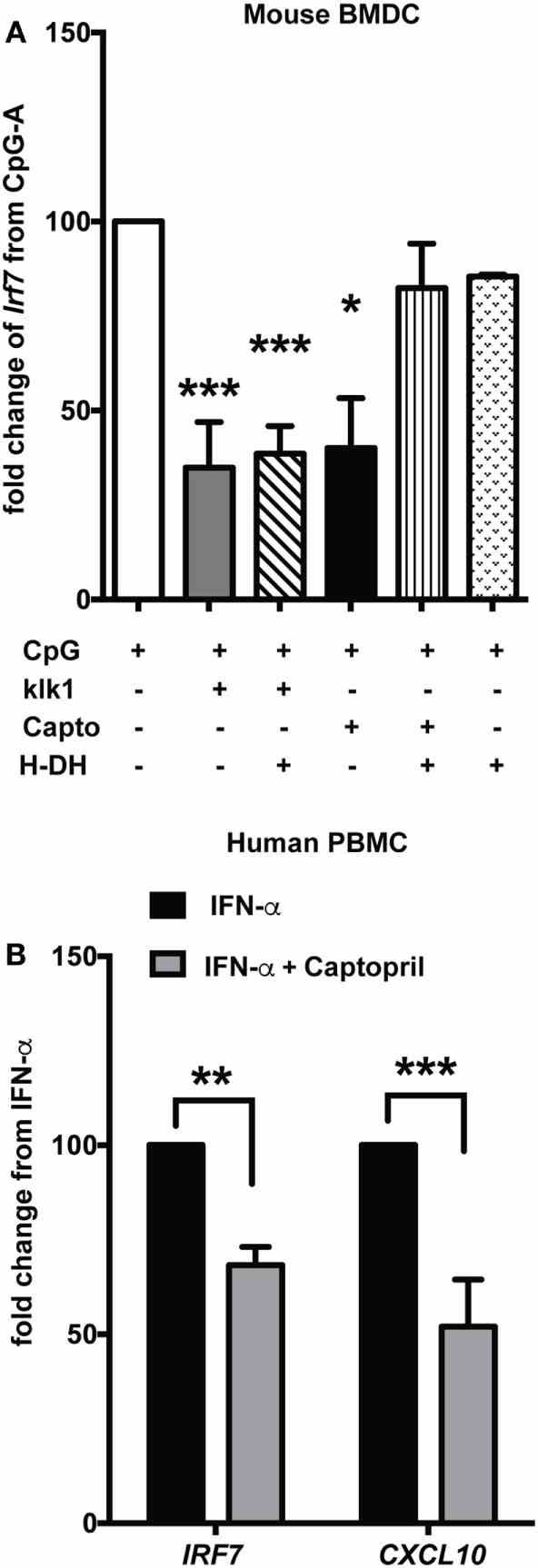Recombinant Human KLK1
| Cat.No. : | KLK1-29686TH |
| Product Overview : | Recombinant full length Human KLK1 , a single, glycosylated, polypeptide chain, predicted Mwt: 28-32 kDa. |
- Specification
- Gene Information
- Related Products
- Citation
- Download
| Species : | Human |
| Source : | Yeast |
| Tag : | Non |
| Protein Length : | 238 amino acids |
| Description : | Kallikreins are a subgroup of serine proteases having diverse physiological functions. Growing evidence suggests that many kallikreins are implicated in carcinogenesis and some have potential as novel cancer and other disease biomarkers. This gene is one of the fifteen kallikrein subfamily members located in a cluster on chromosome 19. This protein is functionally conserved in its capacity to release the vasoactive peptide, Lys-bradykinin, from low molecular weight kininogen. |
| Molecular Weight : | 28.000kDa |
| Tissue specificity : | Isoform 2 is expressed in pancreas, salivary glands, kidney, colon, prostate gland, testis, spleen and the colon adenocarcinoma cell line T84. |
| Biological activity : | Human Kallikrein 1 active. Unit Definitin: 1 unit will hydrolize 1 umole of H-D-Val-Leu-Arg-pNA per minute at pH 8.0 at 37°C Human Kallikrein 1 measured biological activity of no less than 5 Units/mg |
| Form : | Liquid |
| Purity : | by SDS-PAGE |
| Storage buffer : | Constituent:100% PBS |
| Storage : | Please see Notes section |
| Sequence Similarities : | Belongs to the peptidase S1 family. Kallikrein subfamily.Contains 1 peptidase S1 domain. |
| Gene Name | KLK1 kallikrein 1 [ Homo sapiens ] |
| Official Symbol | KLK1 |
| Synonyms | KLK1; kallikrein 1; kallikrein 1, renal/pancreas/salivary; kallikrein-1; Klk6; |
| Gene ID | 3816 |
| mRNA Refseq | NM_002257 |
| Protein Refseq | NP_002248 |
| Uniprot ID | P06870 |
| Chromosome Location | 19q13.3 |
| Pathway | Blood Clotting Cascade, organism-specific biosystem; Endocrine and other factor-regulated calcium reabsorption, organism-specific biosystem; Endocrine and other factor-regulated calcium reabsorption, conserved biosystem; |
| Function | peptidase activity; serine-type endopeptidase activity; |
| ◆ Recombinant Proteins | ||
| KLK1-7198H | Recombinant Human Kallikrein 1, His-tagged | +Inquiry |
| KLK1-605H | Recombinant Human KLK1 Protein, GST/His-tagged | +Inquiry |
| KLK1-2944R | Recombinant Rat KLK1 Protein, His (Fc)-Avi-tagged | +Inquiry |
| KLK1-643C | Recombinant Cynomolgus KLK1 Protein, His-tagged | +Inquiry |
| KLK1-38H | Recombinant Human Kallikrein 1 | +Inquiry |
| ◆ Native Proteins | ||
| KLK1-29685TH | Native Human KLK1 | +Inquiry |
| ◆ Cell & Tissue Lysates | ||
| KLK1-2901HCL | Recombinant Human KLK1 cell lysate | +Inquiry |
| KLK1-743MCL | Recombinant Mouse KLK1 cell lysate | +Inquiry |
Kallikrein–Kinin System Suppresses Type I Interferon Responses: A Novel Pathway of Interferon Regulation
Journal: Frontiers in Immunology PubMed ID: 29456540 Data: 2018/2/2
Authors: Alecia Seliga, Michael Hweemoon Lee, Uma Sriram
Article Snippet:The following reagents were used to stimulate cells: Recombinant human IFN-α (1,000 U/ml, PBL Assay Science, Piscataway, NJ, USA), mouse IFN-α (1,000 U/ml, PBL Assay Science), CpG-B 1826 (10 μg/ml), CpG-A-2336 (5 μg/ml) (IDT Biotechnologies, Coralville, IA, USA), CpG-A-1585 (1 μg/ml) (Invivogen, San Diego, CA, USA), resiquimod (1 μg/ml) (R848; Invivogen) ( , – ), bradykinin peptide (10 μM), Lys-des-Arg(9)-bradykinin, which is a kinin breakdown product and a selective bradykinin B1 receptor agonist (10 μM), Arg–Pro–Hyp–Gly–Phe–Ser–Pro–Phe–Arg B2 receptor agonist (10 μM), B1 receptor antagonist ([des-Arg 10 -HOE140]- DH-1 μg/ml), B2 receptor antagonist (HOE140–H–10 μM) (all bradykinin agonists and antagonists were purchased from Sigma-Aldrich, St. Louis, MO, USA) , recombinant human klk1 (1 μg/ml) (Creative BioMart, Shirley, NY, USA), captopril (20 μM)(Sigma) , and indomethacin (indo) (1 μg/ml) (Sigma) ( ).

Not For Human Consumption!
Inquiry
- Reviews (0)
- Q&As (0)
Ask a Question for All KLK1 Products
Required fields are marked with *
My Review for All KLK1 Products
Required fields are marked with *



